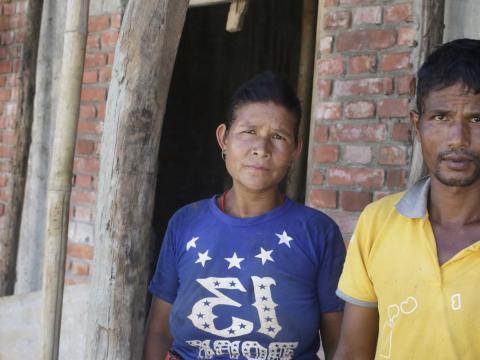A new home for Indra

When I met Indra Bahadur he was excited to move into his new house which is nearing completion.
He belongs to the Majhi community which is regarded as one of the most marginalised indigenous communities in Nepal, their chief source of income primely was fishing and ferrying people across rivers. With time, this dispersed population has begun to embrace occupations favourable to the places of their settlements but still lack behind economically.
Indra’s small community in Bhimtar, Sindhupalchowk lives under similar conditions. Constituting of around 140 households living by the banks of Indrawati River, this community’s chief way of earning is through skilled and unskilled construction work, driving trucks and toiling in the river for sand and gravel. But, 38-year-old Indra had chosen to take a different route; he chose to invest in goat farming and had managed to acquire 30 goats by early 2015.
However, the devastating earthquakes of April 2015 came like a begrudging force, taking away all the houses in this community and to Indra’s despair, 29 of his goats. At the time of the earthquake, he was with his sons at the river banks, few minutes away from his home when the ground started rumbling and all he could think of was his wife back home. Arriving at the scene, he remembers it clear as the day, all houses reduced to rubbles, the shed where his goats were in, in ruins and the horrifying sight of his wife trapped beneath the ruins of his house. He did manage to get his wife out in time but unfortunately, not the goats.
A year passed and in January 2017, Indra found a ray of hope. He heard that an organisation was going to support his community to reconstruct houses and bounce back. It started when he took part in the seven-day training along with 25 other people on safe building practices organised under the guidelines of the Department of Urban Development and Building Construction. All the preconceptions he had about the elements of construction were corrected. He found out that for a house to become strong, its foundation has to at least be 3 feet deep. He also found out the importance of sil and lintel bands, made up from reinforced concrete, in making the walls stronger.
Soon after, a reconstruction committee was formed in this community with 14 members who were in the frontline of taking ownership of the process on the community’s behalf. Indra was nominated as its coordinator and was one of the first ones to actually initiate building his own house. “Everyone was sceptical to begin at first, because the concept was all so new. I was also unsure, but someone had to initiate. After seeing that the foundation of my house was constructed, my neighbours followed suit,” he recalls.
Indra is also one of the first ones to have completed the conditional construction criteria in order to be eligible to receive the final tranche of NRs.1,00,000 (USD 1,000). In addition, he had also received two goats as livestock support from World Vision to resume his goat farming. With this push, he invested into four more goats with a reinstated hope.
His joy is evident as I meet him and he shows me around to his almost-completed house. “We are in the process of roofing the house. We should be done in a few weeks or a month at most,” he says.
With a house that is earthquake-resistant, he will not have to fret about future disasters as much. He looks forward to spending time with his family in his new home.
MORE ABOUT THE PROJECT
- The pilot project, carried out by World Vision and Build Change, with Association for Rural Social Welfare as its implementing partner, is financing the repair/reconstruction of 307 households in 3 wards of Sangachowk, Sindhupalchowk.
- The project works through three approaches: retrofitting, owner driven reconstruction and on the job training support.




